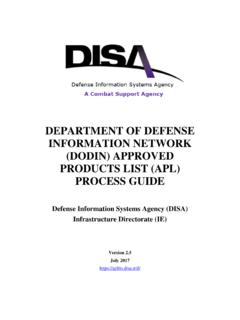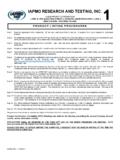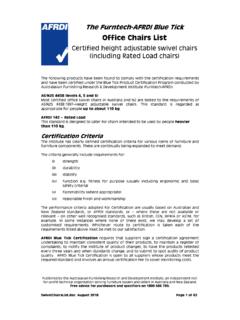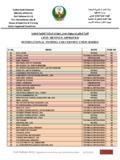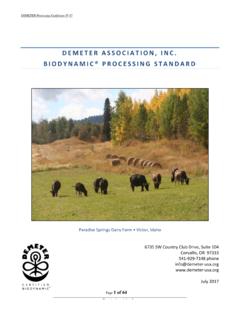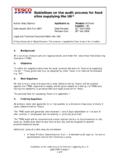Transcription of Q & A on the WHO Certification Scheme
1 Working document May 2010 WHO Certification Scheme ON THE QUALITY OF PHARMACEUTICAL PRODUCTS MOVING IN INTERNATIONAL COMMERCE: Questions and answers (Q & A) The WHO Certification Scheme for finished pharmaceutical products is an international voluntary agreement to provide assurance to countries participating in the Scheme , about the quality of pharmaceutical products moving in international commerce (World Health Assembly resolution (1969), World Health Assembly resolution (1975), World Health Assembly resolution (1988), World Health Assembly resolution (1992), World Health Assembly resolution (1997). The primary document of the Scheme was the Certificate of Pharmaceutical Product (CPP). The WHO Expert Committee on Specifications for Pharmaceutical Preparations, during its forty-third meeting, recommended that the WHO Certification Scheme on the Quality of Pharmaceutical Products Moving in International Commerce should be reviewed in light of the changing environment, including the rapid globalization of the pharmaceutical manufacturing sector coupled with changes in the make-up of both the regulators and the groups involved in procurement.)
2 In addition, as an interim measure, it also requested that a questions and answers (Q & A) document on the function of the Scheme should be prepared (see WHO Technical Report Series, No. 953, pp. 47-48 (2009). The Q & A document, version 1, is found below. Comments and suggestions to improve this document should be sent by 30 July 2010 to Dr Samvel Azatyan, Medicines Quality Assurance Programme, World Health Organization, 1211 Geneva 27, Switzerland, fax: (+41 22) 791 4730 or e-mail: Working document page 2 WHO Certification Scheme ON THE QUALITY OF PHARMACEUTICAL PRODUCTS MOVING IN INTERNATIONAL COMMERCE: Questions and answers (Q & A) Q1 What is the WHO Certification Scheme on the Quality of Pharmaceutical Products Moving in International Commerce? A1 It is a Scheme developed by the World Health Organization (WHO) in response to the request of WHO Member States to facilitate international trade in pharmaceutical products between Member States.)
3 Q2 When was the Scheme developed? A2 It was first developed in 1975. Since then it has been revised in 1988, 1992 and in 1997. Q3 How can it facilitate trade in pharmaceutical products? A3 The Scheme is an administrative instrument that requires a participating Member State (a certifying country), upon application by a commercially interested party (the applicant company), to certify/attest to the competent authority of another participating Member State (the recipient country) that: a specific pharmaceutical product is authorized for marketing in the certifying country, or if not, the reason why authorization has not been accorded; the manufacturing facilities and operations conform to good manufacturing practices (GMP) as recommended by WHO. Q4 Why is it called the WHO Certification Scheme ? A4 It is called the WHO Certification Scheme because it was developed by WHO in response to the request of Member States. Q5 How does the Scheme operate? A5 The Scheme operates as follows: 1.
4 The certificate recipient authority has in its national medicine legislation or guidelines a requirement for the submission of a Certificate for a Pharmaceutical Product (CPP) for products being imported into the country as a support to ensure the quality of the product being imported. (In some countries the CPP forms part of the dossiers to be submitted to the national Working document page 3 medicine regulatory authority (NMRA) to have a product registered by the authority). 2. The applicant/importing company requests a CPP from the certifying authority through the exporting company. 3. The certifying authority issues a CPP to the importing/applicant company via the exporting company. (At the time of the development of the Scheme the understanding was that a CPP would be sent directly to the recipient authority by the issuing authority. The practice at present is as shown in the diagram.) Country A Country B Q6 Is the Scheme mandatory?
5 A6 No, the Scheme is not mandatory. It is a voluntary agreement devised to enable countries with limited medicine regulatory capacity obtain partial assurance from exporting countries concerning the quality, safety and efficacy of the pharmaceutical product they plan to import. Q7 Can any one issue a Certificate for a Pharmaceutical Product (CPP)? A7 No, it is only countries and regional organizations such as the European Medicines Agency (EMA) that are party to the Scheme who can issue a CPP. Q8 How can a WHO Member State or regional organization be eligible for participation in the Scheme ? A8 Any WHO Member State or regional organization intending to participate in the Scheme may do so by notifying the Director-General of WHO in writing, of its willingness to participate in the Scheme ; any significant reservations it intends to observe relating to this participation; and by providing the names and address of its NMRA or other competent authority. Verification in case of doubt Certificate recipient authority Importing /applicant company Certificate Issuing Authority Exporting company Request for CPP, CPP, Working document page 4 Q9 Where can one find the list of organizations and countries party to the Scheme ?
6 A9 WHO publishes the names and addresses of Member States party to the Scheme . The list is available on the WHO web site: A hard copy of the list is also published and distributed to Member States. The list is updated from time to time. Q10 Does the list of Member States and organizations party to the Scheme provide the names and addresses of those government organizations authorized to sign and issue a Certificate for a Pharmaceutical Product (CPP)? A10 Yes, the list provides the names and full addresses of those government organizations authorized to sign and issue a CPP. NMRAs receiving a CPP can use this list to check and verify if the certificate they are receiving has been issued by the authorized organization. Q11 Is there any written document that provides detailed information on the WHO Certification Scheme ? A11 Yes, there are published guidelines called Guidelines for implementation of the WHO Certification Scheme on the Quality of Pharmaceutical Products Moving in International Commerce.
7 One can access these guidelines by going to the WHO website: Q12 What should Member States and regional organizations possess in order to issue a Certificate for a Pharmaceutical Product (CPP) to support the export pharmaceutical products? A12 Member States and regional organizations should have the following to issue a CPP: an effective national licensing system for pharmaceutical products, manufacturers and distributors; GMP requirements consonant with those recommended by WHO to which all manufacturers of finished pharmaceutical products (FPPs) are required to conform; effective controls to monitor the quality of pharmaceutical products registered or manufactured within the country, including access to an independent quality control laboratory; Working document page 5 a national pharmaceutical inspectorate having the technical competence experience and resources to assess whether GMP and other controls are effectively implemented and legal power to conduct appropriate investigations.
8 The administrative capacity to issue the required certificates, to institute inquiries in the case of complaint associated with a potentially serious quality defects or other hazard and to notify WHO and other concerned parties. Q13 Does WHO issue Certificates for a Pharmaceutical Product (CPP)? A13 No, WHO does not issue CPPs or any of the certificates described under the Scheme . Q14 Should a CPP issued by Member States bear the WHO emblem or the acronym WHO ? A14 No, c ertificates should not bear the WHO emblem or the acronym WHO . The use of the emblem or acronym creates the impression that the certificate is issued or endorsed by WHO. It is an illegal act and countries receiving such CPPs should reject them and report to WHO. Q15 What products are covered under the WHO Certification Scheme ? A15 Pharmaceutical products covered under the Scheme are: FPPs intended for administration to human beings; pharmaceutical products intended for administration to food-producing animals; active pharmaceutical ingredients (APIs).
9 There is now a separate Scheme called the WHO pharmaceutical starting materials Certification Scheme (SMACS) which has guidelines on importation of APIs. Q16 What are the different types of Certificates that can be requested within the scope of the Scheme ? A16 Three types of certificates can be requested within the scope of the Scheme : a Certificate for a Pharmaceutical Product (CPP) or Product Certificate (PC); a Statement of Licensing Status of Pharmaceutical Product(s) (SLSPP); a B atch Certificate of Pharmaceutical Product (BCPP). Working document page 6 Q17 By whom and when is a Certificate for a Pharmaceutical Product (CPP) issued? A17 A CPP is is sued by the authorized body of the exporting country and is intended for use by the competent authority within an importing country: when a pharmaceutical product is under consideration for a product license/marketing authorization that will authorize its importation and sale in the importing country; when administrative action is required to renew, extend vary or review such license.
10 Q18 When and by whom is a Statement of Licensing Status of Pharmaceutical Product(s) (SLSPP) issued? A18 An SLSPP is issued by the competent authority of the exporting country and is intended for use by importing agents when considering bids in an international tender. It is requested by the importing agent as a condition for bidding. Q19 What is a Batch Certificate? A19 A Batch Certificate is a certificate that accompanies and attests to the quality and expiry date of a specific batch or consignment that has already been licensed/approved for marketing in the importing country. A batch certificate is usually issued by the manufacturer. In case of biological products, a lot certificate is issued by the competent authority of the exporting country. Q20 Is there a standard format for CPPs? A20 Yes, there is a standard format. The WHO standard format was last agreed by WHO Member States in 1997 (reference: WHO Guidelines, Section ). The standard WHO format for CPPs facilitates understanding and review by the recipient authority.










